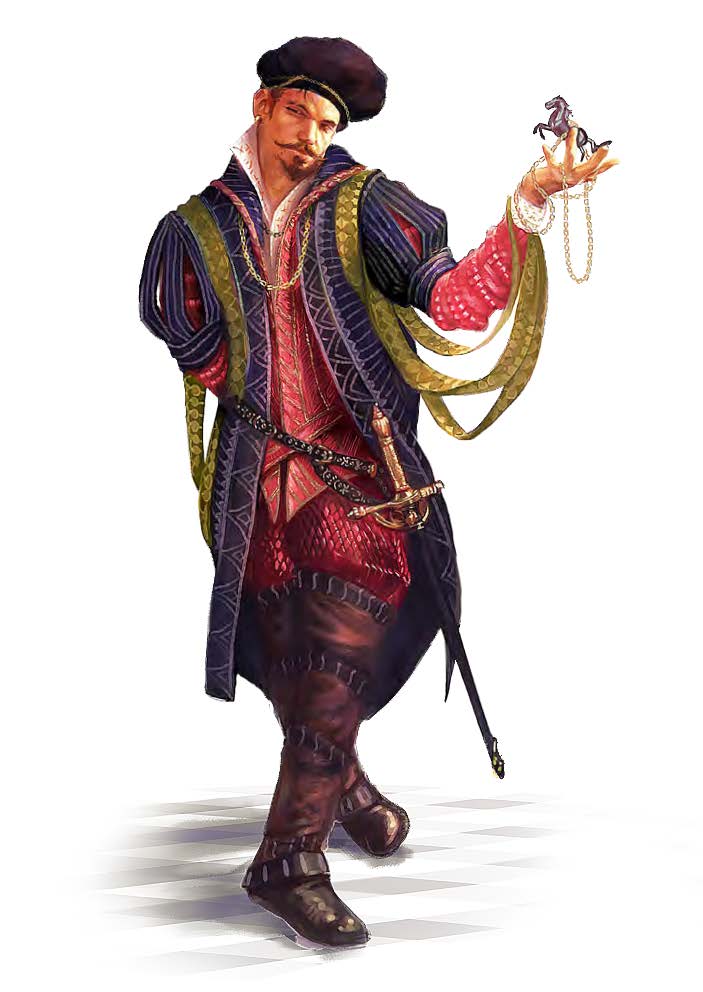 In our last post, we talked about how one-on-one play works best when the PC is flexible in both melee and ranged combat. Today we are going to round out the party by talking about how you can provide the PC with a worthy and supportive adventuring companion. In this post, you’ll find three primary considerations as you build a GMPC for your duet game: complementary class, roleplay, and character motivation.
In our last post, we talked about how one-on-one play works best when the PC is flexible in both melee and ranged combat. Today we are going to round out the party by talking about how you can provide the PC with a worthy and supportive adventuring companion. In this post, you’ll find three primary considerations as you build a GMPC for your duet game: complementary class, roleplay, and character motivation.
In some circles, the phrase “GMPC” elicits shudders and horrified cries of “railroad conductor!” However, when done well, the GMPC can serve a vital role in 1-1. The GMPC should complement the PC’s strengths and shore up their weaknesses. They also give the PC an essential social sounding board and roleplaying partner. And the GMPC opens up compelling narrative possibilities and opportunities for character development. Read on to find out how to explore these three areas at your table!
Consideration #1: Choosing a Complementary Class
Your first consideration as the GM of a one-on-one game needs to be the player. As you create your GMPC, ask yourself: which class have they chosen, and how can my GMPC augment and support their chosen class? As the GM in a duet game, your preferred class matters less than the player’s because, well, you are the GM and get to play all kinds of different characters while your player is focused on the one.
There are some naturally complementary classes that immediately spring to mind. If your player has rolled a wizard, then a tanky barbarian can hold the front line while they sling spells from a safe distance (or vice-versa). Clearly dichotomous pairings like this work really well… until someone needs some healing.
I like picking classes for my GMPCs that can fill multiple roles. Some classes lend themselves particularly well to this kind of flexibility. Paladins are terrific tanks and damage dealers that can still heal and support the PC. Clerics can get in goblin’s faces or righteously injure foes from afar in addition to their strong healing and support spells. And druids are notoriously flexible, having access to healing or other aids as well as being adept at controlling the battlefield.
Consideration #2: Roleplay
Having a GMPC for your one-on-one games supports another crucial element of play: social interaction. When we first started out, I was so concerned about my GMPC stealing the show that he didn’t really talk to the PC. He was the strong, stoic (boring, non-communicative) type. So my player wasn’t as emotionally invested as she wanted to be, and her character wasn’t really developing.
Characters In 5th Edition, just like people, work best when they are not in a vacuum. Our characters need others to bounce ideas off of, reveal backstories to, and butt heads with. Your GMPC should offer a social counterpoint to your player’s character. It was the GMPC opening up and talking with the PC that saved our early duet game.
For this reason, as you make your GMPC, you need to consider a complementary class but also complementary (or contrasting for added spiciness) personality traits. If the PC is bubbly and chaotic, perhaps your GMPC is more grounded and lawful. On the other hand, if your PC tends to believe everything anyone tells them, your GMPC could be more of a skeptic. Or maybe your PC is socially awkward, and you could try making the GMPC a silver-tongued smooth talker.
A word of caution in developing personality traits, subtlety wins every time. Allow the contrasts between the PC and GMPC to emerge slowly for a greater payoff. This gives both you and the player the opportunity to enhance your character building and to dive into intricate, internal issues that manifest over time. Plus, the two characters will shape themselves around one another as their bond grows.
Consideration #3: Motivation
Finally, your GMPC needs to have a strong reason to adventure with your PC. As with bringing any adventuring party together, you want to intertwine their motivations and point them in the direction of your overarching plot and goals.
For one-on-one, you might also give your GMPC reasons to defer to the primary character. For example, maybe the PC has a noble background while the GMPC springs from more humble origins. Or maybe it is as easy as the GMPC functioning as an underling or hired muscle for the PC. The PC needs to remain the narrative character of focus, and the player should be the one calling the shots and making the tough calls.
That being said, I do like for my GMPCs to have enough personality and backstory that their problems or interests offer another avenue or “B plot” to the PC’s main story. Ideally, any adventures related to the GMPC will still factor heavily into the aims and goals of the PC even if it is simply the chance for the main character to assist their important ally.
Closing Thoughts
One of the biggest advantages of playing one-on-one is that you only have two player’s tastes, preferences, and schedules to contend with. You get to play a hyper-focused game, privileging the pillars of play that appeal the most to your table for two.
While the pair of you are co-creating the world of your game, make sure that your player gets to lean into their character. Give them a GMPC to fight alongside, socialize with, and grow closer to as they adventure together.
___
You can find more advice and ideas for one-on-one play at dndduet.com.
